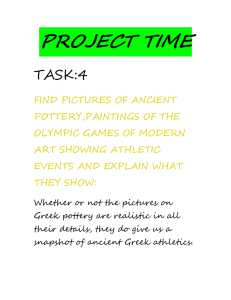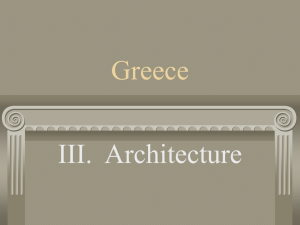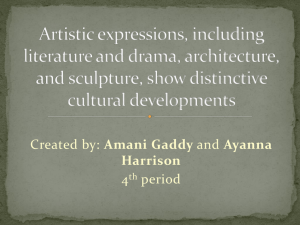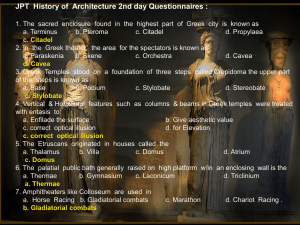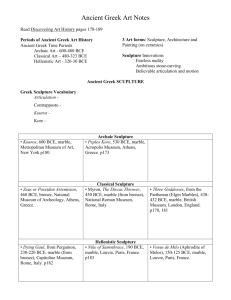ART201 ART HISTORY I
advertisement
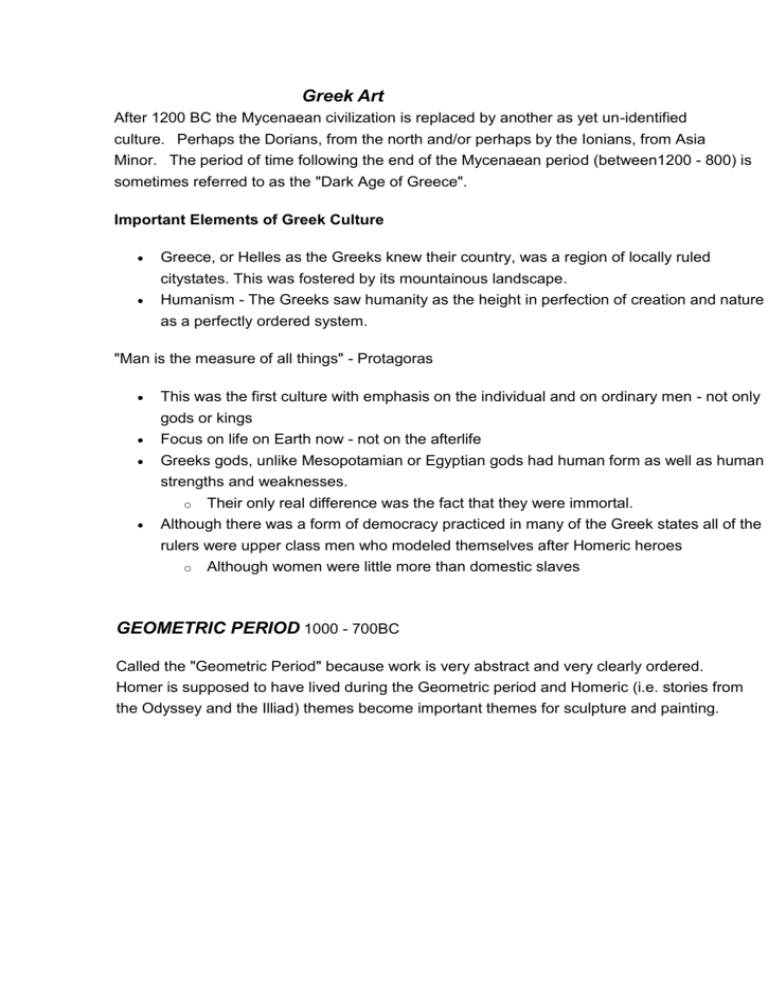
Greek Art After 1200 BC the Mycenaean civilization is replaced by another as yet un-identified culture. Perhaps the Dorians, from the north and/or perhaps by the Ionians, from Asia Minor. The period of time following the end of the Mycenaean period (between1200 - 800) is sometimes referred to as the "Dark Age of Greece". Important Elements of Greek Culture Greece, or Helles as the Greeks knew their country, was a region of locally ruled citystates. This was fostered by its mountainous landscape. Humanism - The Greeks saw humanity as the height in perfection of creation and nature as a perfectly ordered system. "Man is the measure of all things" - Protagoras This was the first culture with emphasis on the individual and on ordinary men - not only gods or kings Focus on life on Earth now - not on the afterlife Greeks gods, unlike Mesopotamian or Egyptian gods had human form as well as human strengths and weaknesses. o Their only real difference was the fact that they were immortal. Although there was a form of democracy practiced in many of the Greek states all of the rulers were upper class men who modeled themselves after Homeric heroes o Although women were little more than domestic slaves GEOMETRIC PERIOD 1000 - 700BC Called the "Geometric Period" because work is very abstract and very clearly ordered. Homer is supposed to have lived during the Geometric period and Homeric (i.e. stories from the Odyssey and the Illiad) themes become important themes for sculpture and painting. Dipylon Krater detail of central scene Dipylon Krater 8th c. 41" h Dipylon is a cemetery outside Athens. Pottery such as these pieces found in the cemetery served as grave markers. The scenes on both vesels depict funerals. The animals beneath the funerary would have been for a sacrifice. They had holes in the bottom and when placed over a grave allowed offerings of oil or wine to seep through into the ground. The Figures in vase paintings are abstract and conceptual, represented as simplified geometric shapes. The composition is organized in registers. The soldiers in the scene are represented as the shield they carried, their symbolic identity. Dipylon Vase The majority of the surface of the vessel 8th c. BC 61" h is decorated with abstract linear designs. Pottery forms you should be familiar with: AMPHORA a storage vessel Dipylon Amphora KRATER a vessel for mixing wine and water KYLIX a round shallow drinking cup ORIENTALIZING PERIOD 700 - 640 BC There is a period where Greek art becomes "orientalized", or influenced by eastern (Mesopotamian and Anatolian) art and design. These design influences traveled via the trade routes from Asia Minor, including Persia, and Egypt. The orderliness of the Geometric Period becomes more dynamic, shapes become more expressive. The figures and animals fill the spaces along with other decorative elements. These ceramic pieces make use of ornamental motifs based on plant and flower forms and feature oriental, fantastic monsters and more realistic animals. Corinthian Amphora c. 625 - 600 BC - 14" h. Corinthian Jug c. 580 BC Animal figures and other forms are very fluid curvilinear as opposed to rectilinear as are they are on the Geometric Period pieces we looked at. CorinthianAlabastron Note how dynamic the shapes and figures are on these pieces and how they fill the spaces around them. Polyphemos Amphora, 675 - 650 BCE, terracotta, 4'8" h. click on the image for a detail On the neck of this amphora a scene from the Odyssey where Odysseus blinds the cyclops, Polyphemos, is described. On the body of the vase the story of Perseus slaying Medusa is described. Note, in the image on the left, how Perseus' body is described as a shield, an imortant part of the story and similar to the treatment of the soldiers on the Geometric Style ceramics . ARCHAIC PERIOD 600 - 490 BC Black Figure Pottery Dionysus in a Sailboat by Ezekias 550 - 525 Ezekias was a master of the Black Figure technique who's style was widely copied by other painters. This vessel is a kylix, a drinking vessel, it's signed by the artist. It illustrates the story of the abduction of Dionysus by pirates. He caused vines to grow all over the ship. The pirates got scared and jumped overboard. Dionysus then turned them all into dolphins. (this is a punishment?) Notice how well Ezekias has utilized the round space of the vessel. Ajax and Achilles Play Drafts An amphora painted by Ezekias illustrating a story from the Iliad. In addition, designs may be incised to create details - curves of the boat, sail, dolphins. Herakles and the Nemean Lion Amphora by Psiax c. 525 Red Figure Pottery Ajax and Achilles Playing a Game Herakles and the Nemean Lion - detail Here in the detail of the painting you can see how the surface is etched to emphasize line and shape bilingual amphora painted by the Andokides Painter c. 525 - 520 BCE Around 530 BCE the Red Figure technique is developed by an anonymous painter known as the Andokides Painter. So called because he painted the pots of the potter whose name was Andokides. The process is essentially the reverse of the Black Figure technique. the difference is that in the Red Figure technique the background is painted with engobe and the figures are left the color of the pot. Details on the figures were drawn or painted on with engobe. detail of the right figure in the amphora comparing the two techniques Here on this amphora the Andokides Painter has created a comparison between the two techniques. The panel on one side is painted in the Red Figure technique, on the other side the panel is painted with the Black Figure technique. Perhaps this was an experiment. Vessels of this type are referred to as "bilingual". Revelers Euthymides c. 510 BCE "Revelers" is a popular theme of the time. Not a profound literary or moral story just a story of three guys partying. The figures are lively and animated in complex poses. Euthymides as created a very believable three-dimensional space through his overlapping of their arms and legs and foreshortening. Notice how the center figure twists and turns. They are actually pretty funny as they prance around each other. Note that the figure on the left is using a krater to drink from! Kraters were large and designed for mixing wine with water in - not for drinking from! There was a lot of pride taken in painting these beautiful vessels and there was good natured, if not very real, competition between workshops. On this amphora Euthymides signed it "Euthymides painted me as never Euphronios could" ! Small Amphora for Perfume c. 420 - 410 BCE ARCHAIC SCULPTURE N.Y. Kouros c. 600 BCE, marble, 6' h. KOUROS - Greek for youth Early kouros figures have the rigidity and formality of Egyptian figures. Compare with Menkure and Khafre The New York Kouros (so called because it is currently in the collection of the Metropolitan Museum of art in New York) has a slim waist and broad shoulders. He is much more energetic than the Egyptian figures. Khafre is much more block-like, more bound by the stone, Koroi (plural) are freestanding. Kouros figures were grave monuments, replacing (or supplementing) the large vessels of the Geometric Period. Calf Bearer (moscophorous) c. 560 BCE, marble, 5'5" h. In contrast to the kouros figures this is an older, respectable, gentleman - symbolized by his beard. He is bringing a calf to the temple, or altar, to make a sacrifice - So he's clothed. Kroisos Kouros c. 530, marble, 6' 4" h Kouros figures may appear stiff, but, they illustrate the Greek interest in realism and accurate observation. They were originally painted with encaustic (pigment in wax) on the clothing, hair, lips, eyes. One characteristic of figurative sculpture of the Archaic Period is their peculiar smile. This is referred to as the "archaic smile". Kouros figures were once believed to be figures of the god Apollo. As they were placed to mark the tombs of warriors the may represent that individual, or an idealized warrior. Certainly, they portray what was (is?) considered to be an ideal of male strength and beauty. Peplos Kore c. 530 BCE, marble, 4' h. Detail "Kore" - maiden The female figure presented a slightly different challenge. They are all clothed. How does the sculptor relate the clothing to the figure underneath? Her left arm originally extended from beneath the fabric and may have held a symbol of her dedication to Athena. She may have been a votive figure in the sacred precinct of Athena on the acropolis in Athens. Or, she may actually have represented Athena herself. This kore wears a "peplos", hence her name. Note the swelling forms of her figure and how the artist describes the figure beneath the fabric in these two pieces. Kore, too, were originally painted. Kore c. 510 BCE, marble, 21.5" h. This lovely Kore wears a chiton a fashionable garment. Note the intricate carving of the surface details. Her right arm also used to reach out, perhaps holding an offering. She has very naturalistic features - note the intricate carving of her hair. Notice, too, the archaic smile of the two kore. GREEK ARCHITECTURE DURING THE ARCHAIC PERIOD Temple of Apollo Corinth, c.550 BCE The Temple of Apollo at Corinth is an Archaic period Doric temple. The columns and elements of the architrave that you see at the left are part of the little that remains of the temple. Originally the temple would have been stuccoed and painted. The Temple of Hera at the Greek colony at Paestum is an excellent example of an Archaic Doric temple that still has a large amount of the structure standing. The temple was built around 550 BCE. You can see from the drawing that it is quite a large building. Notice the massive quality of the columns - and how they will become more slender over time. Notice, too, how large and saucer-like the column capitals are. Hera is the wife of Zeus and an important goddess for women. The earliest Greek temples were made of wood When they began building them in stone the features and structure of the wooden buildings were translated into stone - limestone or marble (dry laid, built without mortar) They were roofed with timbers and tile The floor plan is based upon the plan of megarons Architects developed 3 Orders of Architecture as a way to establish a canonical system that emphasized unity and harmony. The three Orders of Greek Architecture are: The Doric Order The Ionic Order The Corinthian Order Each of the 3 orders is defined by established rules for composition and proportion that can be seen incorporated in the following elements of the buildings: The stylobate, the platform the temple sits on The columns, the posts of the post and lintel structure The entablature, made up of the following elements: architrave ( the lintels), frieze, cornices and the pediment The Doric Order is easily identified because of the simple, conical column capitals and the triglyphs and metopes (tri glif, met o pee). Although the Parthenon (below) is a High Classical Doric temple let's use it to identify some of these elements on the building This drawing illustrates the basic components of the architectural orders The pediment was typically filled with sculpture that related to the deity the temple was dedicated to The order refers only to the elevation, not to the plan The Doric order is the style of mainland Greece - It was considered to be massive and masculine The Ionic order originated in Ionia (Greek colonies in SW Turkey) - It was considered to be slender and feminine The Corinthian order originated in Corinth First used in the 5th c. but not widely used until Roman times - The Corinthian order was considered to be the most perfectly harmonious order of the three Temple of Hera I, Paestum, plan Temple of Hera I, Paestum EARLY CLASSICAL 490 - 450 BCE This is the period of the war with Persia, a time of great victories for Athens and it's rise to prominence in the Greek world. From 499 - 494 Athens aided the Ionian colonies against the Persian invaders. This infuriated Darius and he sought retribution, as well as further territory for Persia. In 490 BCE Darius invaded Greece leading to the famous battle of Marathon where 10,000 Athenians and allies inflicted 6,400 Persian casualties out of the 26,000 strong Persian army while losing only 192 of their men. Darius' son Xerxes tries again and in 480 sacked Athens. The Persians were finally ejected from the area following the equally famous naval battle of Salamis in 479 where a similarly outnumbered Athenian navy managed through superior tactics to destroy the Persian fleet as Xerxes looked on. Protagoras "Man is the measure of all things" The philosopher and teacher Socrates stated that artists should strive to depict the soul of a figure not only it's physical form and that a work of arts value and beauty came from it's accuracy in imitating nature. THE SEVERE STYLE (or Transitional Style, depending upon the writer) is a phrase used to describe certain sculpture of the Early Classical Period. This style is marked by clarity of form, solidity of the pose and the severe expression of the faces of these works. Kritios Boy c. 480 BCE, marble, 34" h Thought to have been carved by Kritios and similar to another sculpture attributed to him is an important, pivotal piece from Archaic style to the more fluid, integrated style of the Classical Period. He has a somber, unsmiling face (severe) He stands at rest, with his weight on one leg illustrating the sculptors knowledge of weight shift and how the human body responds to movement and the shifting of weight. The term used to describe this type of weight shift is contrapposto from the Latin positus positioned contra - against Note the following indications of this description - His engaged hip, the one that bears the weight, is raised -His body shifts around the flexible spine which also serves as an axis for the motion To add further animation to the figure the lower half of his body turns in an opposite direction of upper half of his body. In kouros figures the smile animated the figure. Here motion and animation is created from within the body. Riace Warriors c. 460-450 BCE, bronze, 6'6" h. This pair of bronze sculptures was found in the Riace Marina (hence their name) at the resort town of Calabria in the boot of Italy. They were found underwater by a scuba diver. They were probably part of the cargo of a ship carrying sculpture from Greece to Rome. Following the incorporation of Greece into the Roman Empire in 146 BCE large numbers of Greek statuary was imported by Romans who greatly admired all things Greek. These imported works were commonly copied in marble by workshops for other patrons. The Riace Warriors as they are known show pronounced weight shift and fluid integration of the parts of their bodies. They were produced by the lost wax casting process. Their eyes are inlayed with ivory and onyx, their teeth are of silver and their nipples and lips are copper. These details are added to give them a more lifelike appearance. These figures show the Greek artist's interest in two potentially conflicting modes of description idealism and naturalism. While the description of the figure, his proportion, weight shift, facial features, etc. is very accurate, certainly, his physique is idealized to some extent. This illustrates the Greek emphasis on accuracy and observation of the world around them and also their belief in humanity expressing the highest ideals of the gods creation. During the Early Classical period bronze becomes a highly favored sculptural material for several reasons. It is very attractive and as it ages it becomes more beautiful. It's very strong and lighter than solid marble because the pieces are cast and hollow. Bronze is also very durable for outside sculpture, as it oxidizes it creates a patina the eventually seals and protects the interior of the metal. To cast bronze and other metals the lost-wax casting process is used. The Charioteer of Delphi c. 470 BCE, bronze, 5' 11" high This chariot driver was originally part of a group that included the horses, the chariot and the groom. It was a memorial commemorating victory in a chariot race by King Polyzalos of Sicily (a despot) who owned the horses. Note how the vertical folds of his robe echo the vertical quality of the figure. He looks calm and almost meditative, reflecting on his victory. Again, note the severity of his facial expression and the sculptor's skill in describing it. Discobolus c. 450 BCE, 5'1" h. Roman marble copy after Myron This is a Roman marble copy of an original Greek bronze by Myron. Bronze was the most desirable material because of its strength and beauty, but costly. Myron's Discobolus illustrates controlled tension and potential energy, but it is limited to one plane, there is little depth to it. A carefully composed study of frozen motion. Note how the composition is made up of a series of interlocking arcs. Since this is a marble copy, there wouldn't have been a tree trunk in the original! Poseidon or Zeus c. 460 BCE, bronze, 6'11" h. Most surviving bronzes are from shipwrecks (on way to Rome) as was this one. The actual identity of the figure would be described by the projectile he originally held. If it were Zeus he would have held a thunder bolt, or a trident if it were Poseidon. Like the Discobolus he is captured in a moment of frozen motion, his arms fully outstretched, his weight on his left foot, preparing to shift it back to his right. Doryphorus (Spear Bearer) c. 450 BCE, marble, 6'11" h. Roman copy after Polykleitos Original title of the piece was "CANON". Polykleitos wrote a treatise "The Canon System of Representing the Human Body". Polykleitos described how beauty could be described within a mathematical model. This would be the sculptural equivalent of the use of mathematical proportions in architecture. Both concepts were based upon musical experiments of Pythagoras (Pythagorean Theorem) with musical intervals. He was trying to describe a mathematical structure in nature. Polykleitos strove to integrate these mathematical principles in his description of the human (male) form that Canon (Doryphorus) represents. This sculpture may be seen as the culmination of the evolution from Archaic Kouros figures through Early Classical Severe Style. The body is arranged in a set of balancing forces and diagonal tension - straight leg/arm against bent leg/arm - head turns right - body turns left. This gives the figure a very dynamic quality in spite of it's restful pose. Early Classical Architecture Temple of Zeus Olympia, 465-457 BCE Here in this reconstruction drawing of the facade of the Temple of Zeus at Olympia you can see how the proportion of the Doric order is becoming more refined. The columns are noticeably more slender than those of the Temple of Hera I at Paestum. You can also nicely see the rhythm and repetition created by the triglyphs and metopes on the frieze. Cross section view of the Temple of Zeus showing the colossal statue Of Zeus that was known as one of the 7 Wonders of the Ancient World. Apollo with Lapith and Centaur From the west pediment of the Temple of Zeus at Olympia. (the Lapith has lost his head and arms and stands between the Centaur and Apollo) The story of the "Battle Between the Lapiths and Centaurs" is an important allegorical story that is a popular subject throughout Greek art that presents the conflict between reason and order, and uncontolled emotion. Here, Apollo represents reason and the intellect as he subdues a Centaur. Centaurs represent humanity's less desireable qualities violence, uncontrolled emotion and lack of self-control. The centaur's more emotional, less controlled nature is reflected in his angular pose and contorted face. Apollo, on the other hand, stands straight and forthright in geometric clarity. Truly the essence of classical composition. Sculpture and Architecture of the High Classical Period (450 - 400 BC) The Athenian Acropolis The Athenian Acropolis was the religious center of the city as well as a major source of civic pride. It is the home of several temples and shrines in addition to personal monuments erected by citizens. We will look at the three major temples on the acropolis at Athens, the Parthenon, the Erechtheion and the Temple of Athena Nike. The Parthenon, the large Doric temple just right of center in this view, was designed by Iktinos and Kallikrates and built between 448 and 432 BC to hold the cult statue of Athena sculpted by Phidias who also designed the rest of the sculptural program on the Parthenon. Cult Statue of Athena Parthenon Athena is a virgin, warrior goddess and daughter of Zeus. She is the goddess of wisdom and the Parthenon is dedicated to her. This is a model reconstruction of the cult statue that would have been housed in the cella of the parthenon. The original was made of gold and ivory and was approximately 38' tall. The statue makes many allusions to the recent victories over Persia including the small statue of Athena Nike (her persona of victory) she held in her right hand. Parthenon Ictinus & Kallikrates 448 - 432 The Parthenon is an excellent example of post and lintel construction. The column capitals provide a broad base to transfer the weight of the entablature to the column. In this reconstruction model you can get a sense of what the Parthenon looked like when it was new. Note that it was painted - a very different type of image than the one we have now of the unfinished marble. The roof was terra cotta tile. Harmony, Scale and Proportion The Parthenon is considered to be the most harmonious embodiment of the Doric Order This is attributed to the use of recurring mathematical ratios - the ratio of 4:9 occurs throughout In earlier Archaic temples, such as the Temple of Hera I at Paestum (c. 550 BCE) the stylobate had a proportion of 1:2 Later Classical temples had a proportion of 4:9 approximating the Golden Proportion of 5:8. In this cutaway sectional drawing you can see the relationship of the inner, Ionic frieze and the outer Doric frieze. Notice, too, the sculpture of the 3 Goddesses in the lower corner of the pediment. Three Goddesses (Hestia, Dione and Aphrodite) Originally located in the right hand corner of the east pediment. The composition of the figures allows them to fit into the acute angle. The figures flow together and are very nicely unified. They illustrate a new development of the high classical period in describing the female figure the so-called Wet drapery style. The flowing fabric alternates between revealing and concealing the figure beneath. On portions of the figures it appears to cling to the figure as if wet. These pieces of sculpture placed in the pediments are in the round, not relief. The Erechtheion The Erechtheion, 421- 405 The Erechtheion is a large complex Ionic building named after the legendary king of Athens - Erechtheus. It is a composite shrine built on the site of several previous shrines - the uneven terrain of the site leads to an unusual, innovative plan It sit on the site of the contest between Athena and Poseidon for the dominion of Athens. Porch of the Maidens The Temple of Athena Nike Temple of Athena Nike 427 - 424 BC A small, delicate building dedicated to Athena. In her persona of Athena Nike she represents victory. The Ionic order didn't come into use until the Classical Period It was considered more delicate and "feminine" Nike Adjusting Her Sandal c. 410 BC, marble, 3'6" h. From the balustrade (railing) of the Temple of Athena Nike Is she removing her sandal because she's about to step onto sacred ground ? She has wings, carved in relief, which help her balance while performing this awkward task. Here the wet drapery technique is almost a virtuoso demonstration of carving skill. It reveals the structure of the body of the young woman beneath it and, at the same time, it has a distinctive pattern of folds that create a strong pattern of light and shadow that play across the figure and the surface of the sculpture. LATE CLASSICAL PERIOD (400 - 300 BC) Athenian abuses of the Delian League lead to the Peloponnesian War between Athens and several of the other Greek city states. It lasted from 431 404 BCE. It left Athens in defeat and all of Greece spiritually, politically and economically exhausted. The strife of the war and its effects had a profound influence on the art of the 4th century. Greek artists began to focus more on the individuality of human beings and less and less on idealizing them. Hermes and Dionysus c. 340 BC, marble, 7'1 h Found in the Temple of Hera at Olympia Once believed to be an original by Praxiteles but now thought to be by a student. The work of Praxiteles, one of the masters of the 4th c., illustrates the new move to a more humanistic depiction of the figure. Praxiteles' style emphasizes fluidity of form and the sensuousness of flesh - The curve of Hermes' body is exaggerated - the 'S' curve is a common feature of many of Praxiteles' sculptures - support for the figure is incorporated into the piece (not an artifact of the copying) - Hermes relaxes against it - His musculature is not as emphasized - softer and more sensuous - proportion is more elongated - compare to Polykleitos' Doryphorus Apollo Belvedere c. 330 BC, marble, 7'4 h. Roman copy - displayed in the Belvedere Court of the Vatican, once believed to be the highest achievement of Greek sculpture. He was shooting an arrow at a giant python from an episode in the story of the battle between the Gods and the Giants. THE HELLENISTIC PERIOD 323 - 31 BC The Hellenistic period is a time of broad expansion of the Greek sphere of influence. It begins with the death of Alexander the Great and ends with the defeat of Mark Antony and Cleopatra (who was a Greek queen ruling in Egypt) at the the Battle of Actium by Augustus. In 338 BCE all of Greece comes under the control of Phillip of Macedon. And two years later, in 336, he is assassinated. His son Alexander succeeds him and in a period of 10 years created an empire that extended all the way to India in the east. His defeat of the Persian Empire is the final revenge for Persia's attacks against Greece in the 5th century. As a result of his broad expansion of the Greek world the Greek vision of the world expands. Centers of culture are no longer centralized on the Greek mainland. Antioch in Syria, Alexandria in Egypt, and Pergammon in Asia Minor become major centers of the arts, culture, education and government. An international Greek culture tied together the far flung elements of the empire. There is greater exposure to Near Eastern concepts. Following Alexander's death there is much chaos and upheaval and the Romans are a growing threat. The Romans absorb the Greek empire beginning with the Greek mainland in 146 BC. Dying Gaul 230 BC, 36" h. Roman marble copy of a Greek bronze original Art of the Hellenistic period is very dramatic and theatrical. Sculpture becomes very expressive and emotionally charged. Here the agony of a painful death is expressed in the figure of the fallen warrior whose blood flows from the wound in his chest. This fallen warrior was part of a sculptural group at Pergamon. The sculptural group celebrated the defeat of the Gauls who were marauding around the eastern Mediterranean and Asia Minor until defeated by Atalos I, king of Pergamon. Generally, this expression of suffering may reflect the changing of the Greek world, from that of a very orderly one of Greek origin to one of a broader world and its (barbaric) influences. Nike of Samothrace c. 190 BC, marble, 10'9" h Samothrace is a northern island of Aegean This is a monument to the victories of the navy of Rhodes over the Syrians Athena Nike is shown alighting on the prow of a war galley. She is still partially airborne - just about to land. It has a real a sense of wind and motion - her forward motion creates an active relationship with the wind as she flies into it. Her garment is pressed tautly around her by the wind. It reveals the dynamic form of her figure beneath it. Altar of Zeus at Pergamon c. 175 BC, frieze 7'7" h Pergammon was a wealthy city and one of the Hellenistic centers of culture and power. The altar was built by Attalus to commemorate his father's (Attalus I) victories against the invasion attempted by the Gauls in Asia Minor after they had invaded and sacked other parts of the Greek world. Atlas is described as "saving the Greek world". Athena and Alkyoneus fr. Altar of Zeus at Pergamon The victory is represented as a mythological allegory by a scene from the battle between the Gods and the Giants. The scene of Athena battling with the Giant, Alkyoneus is one scene from the story. The analogy between Attalus and the Olympian gods gives his victories and the related human suffering a grander context - relating the Greeks to the Olympian Gods and the Gauls to the Giants - it also ties his father with the gods The frieze is very ornate - baroque dramatic Laocoon 1st c. BC, 8' h click on the image for a larger scale view Carved from one piece of marble Again, there is reference to the suffering and changing Greek world and the almost melodramatic style of Hellenistic sculpture. (remember that the Greeks invented drama) Laocoon was a Trojan priest who warned about the wooden horse sent by the Greeks. Poseidon, who had sided with the Greeks in the Trojan War sent the giant serpents. - not heroic, exaggerated/anguished expressions Laocoon was excavated in Rome in 1506 Michelangelo witnessed the excavation.

